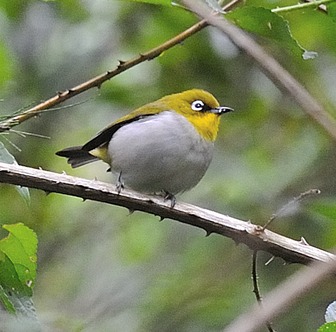Madagascar White-eye
Its natural habitats are subtropical or tropical dry forests, subtropical or tropical moist lowland forests, subtropical or tropical mangrove forests, and subtropical or tropical moist montane forests.

Original source: Yvette Biron
Author: Yvette Biron
Permission: GNU Free Documentation License
The Madagascar White-eye is classified as Least Concern. Does not qualify for a more at risk category. Widespread and abundant taxa are included in this category.
Madagascar white-eye, Zosterops maderaspatanus, is almost indistinguishable from the New Guinea white-eye, Z. novaeguineae; the Annobon white-eye of Gulf of Guinea, Z. griseovirescens, is very similar to the Christmas Island white-eye from south of Java, Z. natalis; and the Australian yellow white-eye, Z. luteus, has the same plumage color as the East African subspecies of the white-breasted white-eye, Z. abyssinicus flavilateralis. Indeed, the relationships between the African and Asian species of Zosterops are yet to be clarified. More
Aspects of the topic Madagascar white-eye are discussed in the following places at Britannica. Assorted References * distribution of waterfowl (in anseriform (bird order): General features) ...and the mallard (Anas platyrhynchos), both found throughout the Northern Hemisphere; in the latter are the Hawaiian goose, or nene (Branta sandvicensis), and the Madagascar white-eye (Aythya innotata). More
Facts about Madagascar white-eye: distribution of waterfowl, as discussed in anseriform (bird order): General features: = ...and the mallard (Anas platyrhynchos), both found throughout the Northern Hemisphere; in the latter are the Hawaiian goose, or nene (Branta sandvicensis), and the Madagascar white-eye (Aythya innotata). Extinction has taken at least six species within the last century, with another three likely extinct, having not been seen for a number of... More
Family : Zosteropidae
Genus : Zosterops
Species : maderaspatanus
Authority : (Linnaeus, 1766)
